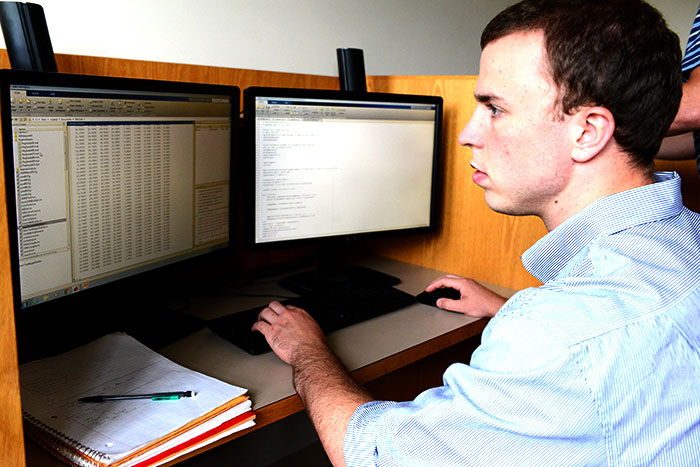Cadet Computer Model Predicts NBA Outcomes

James Snyder '13 works on a computer model. -- VMI Photo by John Robertson IV.
Cadet James Snyder ’13 didn’t have any trouble picking a topic for his Summer Undergraduate Research Institute project. After all, he’s an applied math major with a lifelong interest in sports – so why not delve into the use of statistics to predict the outcome of basketball games?
This summer, Snyder is working under the guidance of Maj. John David, assistant professor of applied mathematics, to take data from several seasons’ worth of NBA games and use that data to build a computer model which can predict the outcome of future games.
Snyder, a Georgia native and avid fan of the Atlanta Hawks, got interested in doing a sports-oriented summer research project when his friend Will Lucas ’14 did a similar project on baseball last summer. David, also a lifelong sports enthusiast, already had experience with predicting professional football games, and he’d overseen Lucas’ work, so he welcomed Snyder’s interest.
Snyder began by taking NBA statistics from six seasons. With 30 teams in the association, each playing 82 games per season, and 32 statistics available per team, Snyder found himself almost drowning in information.
“There are millions of data points,” Snyder commented. “We’re taking all that data and using it to make future predictions for the games.”
To check for accuracy, Snyder fed data from the 2004-2009 seasons into the computer and asked it to make predictions for the 2010 season.
So far, Snyder’s program has racked up an impressive accuracy rate of 72 to 73 percent – which puts him in a position to be competitive with or even outdo, popular websites that claim to be able to predict the outcomes of games.
“We’re on pace with those guys, and I’m pleased with that,” he said.
For Snyder, the summer project has been an ideal capstone to his time at VMI, which is rapidly coming to a close. “You get to do math and see the outcome of sports,” he said. “That’s fascinating to me. We’re doing some pretty complex math techniques, … and at the same time we get to play with basketball statistics.”
Snyder has already accepted a job with the Applied Physics Lab at Johns Hopkins University in Baltimore, Md., which has hired several VMI graduates over the past few years. There, he’ll be testing technology for submarines and other forms of undersea warfare. His work there will begin Aug. 12.
“I’m hoping to take some of the research I’ve done this summer and apply it on the military/government side of things,” said Snyder, who played center on the VMI football team during his cadetship.
And since he’ll be in the neighborhood, Snyder is planning to join David to give a presentation on math and sports at a meeting of three major mathematical organizations, to be held in Baltimore in January.
“The interest in using quantitative analysis in sports has really grown in the past 10 or 15 years,” said David, who enjoys informal games of pickup basketball with a group of professors and cadets.
He continued, “It’s a fascinatingly rich thing in math. It’s a rich area for machine learning and quantitative analysis and data mining. …It’s a wonderful training tool. I can trick [the cadets] into some of this stuff by using sports.”
.svg)
.png)